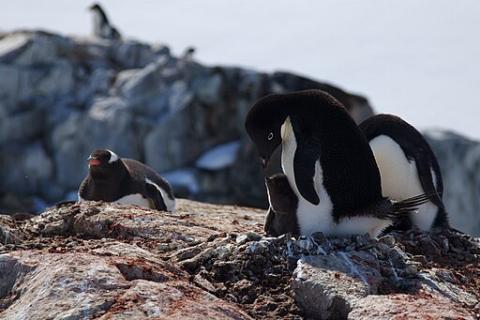Polar ecosystems, including the Antarctic coastline, are some of the environments most sensitive to climate change. As such, understanding the timing of life events (also known as the phenology) of organisms that live in these ecosystems will be important for their long-term conservation. The ability to predict the phenology changes brought on by increased anthropogenic greenhouse gas emissions will be vital to protecting species like the Adélie penguin (Pygoscelis adliae). Adélie penguins are a good indicator species for changes in marine ecosystems, so much so that they have been called the most important animal species used to monitor the Southern Ocean (Jarman et. al 2013). Understanding their lifestyle is incredibly important for understanding the health of the Antarctic ecosystem. One of the ways researchers can observe this is through acoustic data.

Adelie penguins and their chick (on the right) and a Gentoo penguin (on the left). Jason Auch, CC BY 2.0, via Wikimedia Commons.
The goal of my project, conducted through the Research Experience and Apprenticeship Program (REAP) in the Hamel Center for Undergraduate Research, was to determine if the bioacoustics of an Adélie penguin colony change when there are eggs present versus when the eggs have hatched and there are chicks present. This idea was tested by analyzing the frequency spectra of recordings taken from the colony between November 27, 2022, and February 27, 2023. A frequency spectrum shows the distribution of energy (which can be thought of as volume) across different frequencies for a given sound (in this case, a penguin call). Jouventin and Aubin (2002) found that most of the energy in the call of an adult Adélie penguin is within the frequency range of 300-2500 Hz. This could indicate that information (such as the identity of the parent or the chick) is encoded in calls at this range. As such, this was selected as the range of interest for this project. I hypothesized that there would be a change in the amount of energy contained in this frequency range after the chicks hatched. If there is a significant change in the frequencies either before or after the eggs hatched, researchers could predict changes in the hatching time of this species based on a change in the acoustics of the colony.
Methods and Analysis
The dataset I analyzed in the Ecological Acoustics and Behavior Lab at UNH was collected in Antarctica by a colleague of my faculty mentor, Dr. Laura Kloepper. Dr. Megan Cimino was living in Antarctica as part of the Palmer Antarctica Long-Term Ecological Research (LTER) program (NSF ANT – 2026045). While there, Dr. Cimino collected acoustic data and surveyed penguin nests. Egg, nest, and chick counts were taken throughout the time period at each of the sites surveyed. The number and frequency of surveys conducted was different for each site. The sites were located on two different islands, Torgersen and Humble, which are off the coast of mainland Antarctica.
Prior to doing any data analysis, I had to account for interference from wind. To do this, I took frequency spectra from each site, in 5, 8, or 10 second sound bites, that contained only wind and no noise from any animals living at the sites. This data was taken using Audacity, which is a sound-editing software. I also looked at the center frequency, peak frequency, 95% frequency, and 5% frequency using Raven Pro, which is a sound-analysis software created by the Cornell Laboratory of Conservation Biology. I had 20 replicates at each site, each one spanning across different days.
It was evident that the wind interference was focused on the lower part of the frequency spectrum. I then needed to determine where to place a high-pass filter to remove all of the sound below a certain frequency threshold. To do this, I found three ten-second-long sound bites: one containing just wind noise, another containing just penguin calls, and another containing both. I found the frequency spectra in Audacity for each sound bite without a filter, and then when a 100 Hz, 150 Hz, 200 Hz, 250 Hz, and 300 Hz filter were applied manually. The 250 Hz filter produced the most similar measurements when applied to the sound bites that contained just penguin calls, and the penguin calls with wind interference. The filters were then batch applied to all the sound files I wanted to test further using a code developed in R by Lisa DiSalvo, an intern working in the EAB lab.

A screenshot of a spectrogram of multiple Adelie penguin calls. The x-axis represents time, the y-axis represents frequency (Hz), and the color intensity represents volume (dB).
My data collection process focused on three of the sites chosen because they contained the most complete combination of acoustic recordings as well as egg hatching and analysis data. Two time periods were tested: the week of November 27, 2022, to December 4, 2022 (pre-hatch period), because it was the earliest date at which acoustic recordings were collected; and the week of December 25, 2022, to January 1, 2023 (post-hatch period) because it was the earliest date when all three sites were known to have chicks. The pre-hatch period for one site had to be reduced to November 27 at 14:00 to December 2 at 12:00, as the acoustic recorder had been squashed by a southern elephant seal (Mirounga leonina). All files were tested in 24-hour periods from 14:00 to 13:00.
I analyzed the files using an ANOVA test to see if the different days produced statistically significant results. They did, and much of the interference came from other animals, such as seals and other seabirds in the environment. Because of the scope of the analysis that needs to take place to determine if there is a significant difference between the pre and post hatch data, my initial research question has not been answered. This will be pursued by Danielle Fradet, a new graduate student in the EAB lab.
Conclusion
By analyzing the soundscape of an Adélie penguin colony, scientists should be able to understand the long-term population trends of that colony. Through this, scientists can gain a better understanding of how healthy the Antarctic continent and its surrounding waters are. If there is a large change in the Adélie penguin population (which will be able to be monitored more easily, thanks to bioacoustics), it can be inferred that there is a change occurring in the environment surrounding Antarctica.
As more wildlife ecology and conservation fields begin to rely on electronic and digital tools in addition to traditional field work, it is incredibly important for me to have skills in both areas. Through my REAP in the EAB lab and working with acoustics analysis software, I learned to “speak the language” of bioacoustics. This will become important for me going forward as more scientists adopt passive acoustic monitoring techniques into the surveys.
After this experience, I decided to pivot in my research career. Right now, I am working as an undergraduate researcher in the lab of Dr. Becca Rowe alongside her Ph.D. student, Joshua Willems, analyzing how different amphibian species respond to timber harvesting methods in the White Mountains.
I would like to thank Dr. Kloepper for her mentorship and guidance throughout the whole course of this project. Without her leadership, my work for this project would not have been possible. I would like to thank her for her work to obtain the data from the field, along with Dr. Megan Cimino from UC Santa Cruz and NOAA SWFSC Environmental Research Division. All field data collection was done in accordance with the permitting requirements of the Antarctic Conservation Act; the ACA permit number for the field data collection was 2021-002. This field data collection is part of the Palmer Antarctica Long-Term Ecological Research (LTER) program (NSF ANT – 2026045). I would also like to thank Lisa DiSalvo and Joe Brousseau for their work to develop the R code for this project. I thank Danielle Fradet for serving as a graduate student mentor who was always willing to help me with my work and for being there to answer the many questions that I had. Thank you also to the Hamel Center for Undergraduate Research for providing financial support for my research, specifically Mr. Dana Hamel and the J. Raymond Hepler Endowed Fund. Finally, I thank everyone who worked in the Ecological Acoustics and Behavior Lab for being so supportive of my work and creating a great research environment.
References
Carravieri, A., Cherel, Y., Jaeger, A., Churlaud, C., & Bustamante, P. (2016). Penguins as bioindicators of mercury contamination in the southern Indian Ocean: Geographical and temporal trends. ENVIRONMENTAL POLLUTION, 213, 195–205. https://doi.org/10.1016/j.envpol.2016.02.010
Cossa, D. (2013). Marine biogeochemistry: Methylmercury manufacture. Nature Geoscience, 6, 810–811. https://doi.org/10.1038/ngeo1967
FREQUENCY SPECTRUM definition and meaning | Collins English Dictionary. (2023, November 5). https://www.collinsdictionary.com/dictionary/english/frequency-spectrum
Jarman, S. N., McInnes, J. C., Faux, C., Polanowski, A. M., Marthick, J., Deagle, B. E., Southwell, C., & Emmerson, L. (2013). Adélie Penguin Population Diet Monitoring by Analysis of Food DNA in Scats. PLOS ONE, 8(12), e82227. https://doi.org/10.1371/journal.pone.0082227
Sun, Y., Lu, Z., Xiao, K., Zeng, L., Wang, J., & Gabrielsen, G. W. (2020). Antarctic Adelie penguin feathers as bio-indicators of geographic and temporal variations in heavy metal concentrations in their habitats. ECOTOXICOLOGY AND ENVIRONMENTAL SAFETY, 206, 111135. https://doi.org/10.1016/j.ecoenv.2020.111135
Author and Mentor Bios

A native of Towson, Maryland, William Brandenburg is a wildlife and conservation biology major and animal behavior minor at the University of New Hampshire. He will graduate with a bachelor of science degree in spring 2026 as a member of the University Honors Program. His acoustics research in Dr. Kloepper’s lab was funded by a Research Experience and Apprenticeship Program (REAP) grant through the Hamel Center. William joined the lab in the spring of 2023 and felt that working with penguins, which are only native to the southern hemisphere, was a unique opportunity. This is his first research project, and along with technical skills such as acoustics calculations and statistical analysis, he gained invaluable appreciation for the research process, including collaboration and overcoming setbacks in the lab. For William, submitting to Inquiry served to share and document the knowledge and accomplishments he gained through his project. After graduation, he hopes to continue down a research path by pursuing a doctorate and career in ecological conservation.
Laura Kloepper is an assistant professor in the Department of Biological Sciences at the University of New Hampshire. Dr. Kloepper specializes in animal bioacoustics, acoustic ecology, and animal communication. William’s research is an extension of the work in her lab using acoustic recordings to monitor animal populations and behavior. In particular, the lab focuses on dense aggregations of vocal animals that are typically difficult to monitor. They had the opportunity to take on this exploratory research by collaborating with colleagues in Antarctica, who helped collect vocalizations from nesting Adélie penguins. This created new challenges in collecting data without being in person to help with equipment – including the surprise issue of elephant seals sitting on top of the recorders and breaking them! Dr. Kloepper has been mentoring undergraduate researchers for eleven years, including Inquiry author, Keegan Eveland. She believes writing for Inquiry is a great way to develop skills in communicating research to non-scientific audiences, adding: “Albert Einstein once said, ‘you do not really understand something unless you can explain it to your grandmother.’”
Copyright © William Brandenburg
